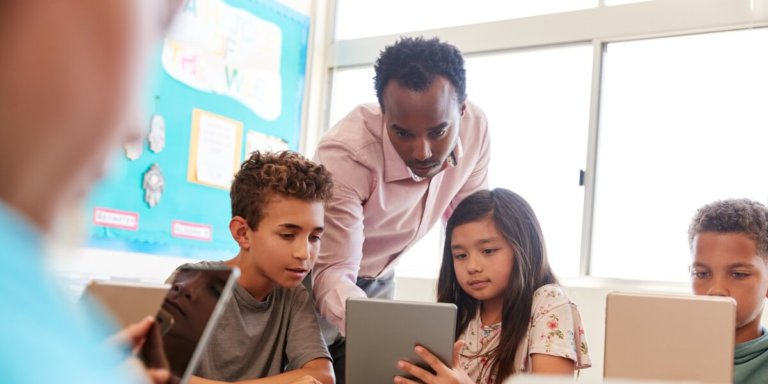
The education landscape is transforming before our very eyes, where teaching approaches are becoming more student-centered and classroom designs are becoming more flexible in schools to allow for more collaborative learning.
With the rapid growth of the educational technology industry, teaching methods today are also relying more and more on technologies like artificial intelligence and even robots.
In this era of disruptive technologies, what’s in store for your school in 2020? Here’s a look at some key education trends that will shape and influence schools in the coming year.
Artificial Intelligence Learning
Exciting to host 121 teachers from 83 primary & secondary schools yesterday in hands-on Artificial Intelligence intro masterclass.
When we inspire the teachers on the opportunities & applications of AI, we indirectly embed AI into learning.
All attendees got our free AI books pic.twitter.com/eRqLOzcfUa— DataScienceNigeria (@DataScienceNIG) December 13, 2019
The role of the teacher in schools is slowly changing. Instead of feeding information to students and lecturing from the front of the room, teachers are playing a facilitating role instead – guiding students towards thinking for themselves and carrying out projects and activities for students to work on in groups.
Assisting teachers in this new role is artificial intelligence (AI). According to Online Education for Higher Ed, AI use in US classrooms will grow by 47.5 percent in the next three years.
The technology is predicted to allow teachers more time to focus on more human-specific teaching skills like emotional intelligence and creativity. AI will take over the time-consuming and monotonous tasks like checking papers for plagiarism or tests.
“Hybrid homeschooling models like Dida offer an alternative to the rigidity of conventional schooling, while providing support and structure to families who otherwise may not consider the homeschooling.”
Education will change dramatically in coming years.https://t.co/E5807aZBTK
— Michael Krieger (@LibertyBlitz) August 28, 2019
Hybrid homeschooling
Parents who choose to homeschool their kids have plenty of support nowadays thanks to technology. If they have gaps in their knowledge or are unable to teach a subject effectively, they can use online modules or face-to-face classes in a more traditional schooling environment to supplement their education.
This is known as hybrid homeschooling, and it’s predicted to become more popular in years to come. It allows for more flexibility, particularly for parents who want to homeschool their children but are unable in one way or another to do so.
Mike McShane, director of national research at US education reform organisation EdChoice wrote in Forbes: “For many families, the costs and obligations related to homeschooling are simply too burdensome. Some parents don’t have the confidence in their own abilities to teach every subject to their children. Others cannot devote themselves to homeschooling full-time. Perhaps most of all, many homeschooling families want their children to socialise with other children to learn how to share, cooperate and get along with others.
“Enter hybrid homeschooling, a model where children split their time between homeschool and a more traditional schooling environment. This could be three days at home and two days at school, two days at home and three days at school, part of the day at home and part of the day at schools, or a variety of other options.”
Augmented Reality (AR)
Check out this whole new dimension to books made possible with augmented reality! 📖 #books #reading #Kindle #authors #amreading #Amazon #read #fantasy #book #tech #classics #school #VirtualReality #AR #MR #VR #IoT #AugmentedReality #MixedReality #JARVIS #BlackMirror #BigData pic.twitter.com/WzP7A1i39G
— The Futurist (@TheFuturist007) January 9, 2019
AR is becoming popular in schools, allowing more three-dimensional experiences that bring abstract concepts to life for students.
This interactive experience adds digital elements by using a camera on a smartphone to a live view, such as Snapchat filters.
In classrooms, AR animated content could be a tool to motivate children to study. They can understand topics better if extra data – such as fun facts, historical information or visual 3D models – are added to classroom lessons. Or when they can scan parts of their books, there are texts, audio snippets or videos from teachers that pop up.
Virtual Reality (VR)
1st graders went to the North Pole today with Google Expeditions. Then we used what we learned to build a @CoSpaces_Edu winter wonderland. pic.twitter.com/mL2kYaMMba
— Heather Cleland (@HSCleland) December 17, 2019
Compared to AR, VR is more immersive, where students can be transported to different worlds with the use of VR goggles such as Google Lens.
It is also becoming more widely used in schools, as the industry is seeing major growth with heavy investment around the world, leading to a bigger market and more affordable products in the edtech sector.
With VR, students can experience what they read beyond word descriptions and book illustrations. Tricking the body into thinking it’s a new place, VR tools like Google Expeditions allow students to visit cultural sites around the world without ever leaving the classroom or even go back in time to a historical setting such as the land of the dinosaurs.
Liked this? Then you’ll love…
4 European edtech start-ups to look out for in 2020
4 UK-based EdTech start-ups that are transforming the way we learn







